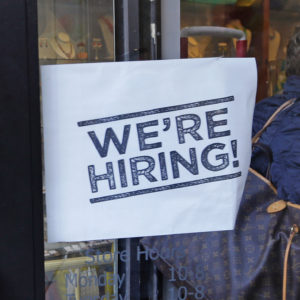A federal report recently revealed that employment growth dropped well below its monthly average, prompting the question of what likely happened.
President Donald Trump entered office at a time of steady employment growth. The trend continued for his first month in office but dropped in March. The Bureau of Labor Statistics announced last week that employment increased by only 98,000 new jobs that month.
The previous jobs reports over the last year usually saw higher job growth, closer to 200,000. The drop in new jobs could be indicative of a number of factors, including reactions to proposed policy changes, weather, and an employment slowdown. The drop in employment growth is likely isolated, but it might also indicate the beginning of a trend.
“This might be an indicator, but it’s too soon to evaluate,” Conerly Consulting President William Conerly told InsideSources. “The month to month job numbers vary a lot, and this could just be part of the normal variation. But it is in the direction that I was expecting towards slower growth of employment gains.”
Conerly previously predicted the possibility of an employment slowdown. The new administration might actually cause the slowdown as it pursues major policy overhauls. The business community supports much of the new agenda, but the political shifts still create a lot of uncertainty for them.
“I think we need to wait a few more months before we can really know whether this is the uncertainty slowdown that I have been worried about,” Conerly said. “I’ve been impressed with the conflict between the uncertainty that business leaders feel, and the optimism that they feel.”
Conerly adds a trend can be seen more reliably with at least a few jobs reports. The employment growth might very well jump back to normal in the next report. Nevertheless, an employment slowdown is becoming a greater possibility as the economy also moves closer to full employment.
“[It] will begin to slow as we get closer and closer to full employment,” Moody’s economic director Ryan Sweet told InsideSources. “But I think that’s going to be more of a story towards the second half of this year than it is now.”
The unemployment rate has hovered around 4.5 percent for several months. Employment growth is likely to slow as the labor market moves towards full employment because there are fewer people to fill new positions. Sweet notes the recent numbers are more likely the result of the other factors, like the weather.
“March is mostly a weather story in that this winter has been unseasonably warm,” Sweet said. “That boosted job growth in January and February, and because weather normalized in March, we got some payback.”
The employment rate doesn’t factor in those that have dropped out of the labor force due to long-term unemployment. The labor force participation rate, in contrast, tracks the number of employed and those actively seeking work as a percentage of the total population. Those that are able-bodied and working age could cause further employment gains by reentering the workforce.
The participation rate has dropped considerably since the last recession and now it’s at 63.0 percent. Center for American Progress economist Michael Madowitz notes recently proposed policy reforms might have caused the weak employment numbers. He points to a proposed blueprint designed to overhaul the tax code.
“The main tax plan provides a pretty strong incentive to delay investments,” Madowitz said in an email to InsideSources. “If businesses have it seriously and put off investments to game the tax code, that could slow the economy down. There’s also the overall budget picture—Obama left with the budget as strong as it’s been in a decade, but the tax cuts would blow up the budget, and that does seem to be pressuring interest rates higher.”
Congressional Republicans introduced the blueprint last year. It’s designed to overhaul the entire tax system. The blueprint primarily focuses on lower rates and simplifying the tax code. Even some supporters of the plan, however, are concerned with provisions like the border adjustment tax.
The AFL-CIO, the largest national federation of unions, notes the jobs report was tepid, but still aligns closely to the positive trend in employment growth. The union credits former President Barack Obama for helping to start the positive employment growth while in office.
Obama entered office during an economic downturn now known as the Great Recession. The recession was sparked by the subprime mortgage crisis and the financial crisis of 2007. The former president oversaw solid economic growth towards the end of his presidency following an irregularly prolonged recovery.
Trump has promised to protect domestic workers from unfair foreign competition. He has primarily focused on trade and immigration. Some have expressed concern that too much economic protectionism could cause problems, even for the domestic workers it’s meant to help.
The Congressional Budget Office (CBO) found in its budget outlook report that workers face slow wage and labor market growth over the next couple of decades. The participation rate is also expected to fall even further over that time.

